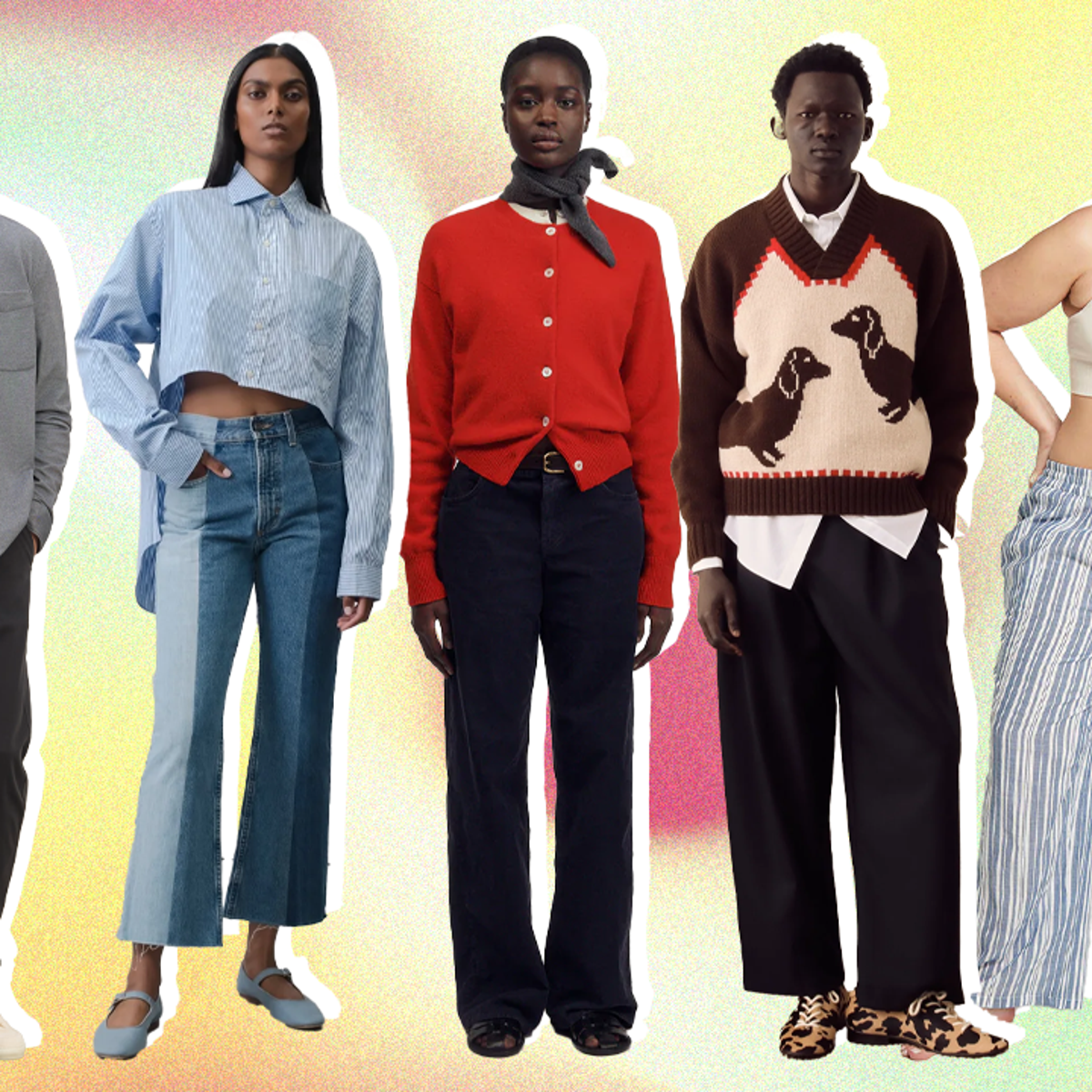Branded Clothing and the Rise of Recycled Fabric Use in Fashion
Branded Clothing and the Rise of Recycled Fabric Use in Fashion
Blog Article
The Significance of Lasting Clothing: Just How It Impacts the Setting and Your Closet
Lasting apparel is progressively recognized for its crucial duty in minimizing the environmental effect of the rapid garment industry. By concentrating on eco-friendly materials and moral production techniques, it resolves pressing environmental concerns. This shift not just benefits the world but additionally affects consumer selections, resulting in an extra thoughtful approach to closet administration. Comprehending these dynamics raises necessary questions about fashion's future and personal duty in shaping it.
The Environmental Footprint of Quick Fashion

Advantages of Lasting Materials
Lasting products supply significant advantages, especially with environment-friendly fabric options that lessen ecological harm. These products likewise show durability and durability, minimizing the requirement for frequent substitutes. As an outcome, they add to an extra lasting apparel industry and promote responsible customer behavior.
Eco-Friendly Textile Choices
While the style industry has actually long been associated with quick patterns and environmental injury, the surge of environment-friendly textile options presents a transformative opportunity. Lasting materials such as natural cotton, hemp, and Tencel have gained appeal due to their reduced environmental impact. These fabrics are frequently produced without harmful pesticides and require much less water, lowering their carbon impact - Branded Clothing. Furthermore, many environmentally friendly textiles are biodegradable, adding to a round economic situation by reducing waste. Picking sustainable products not only sustains ecologically responsible techniques however also advertises healthier ecological communities. As consumers end up being more knowledgeable about their purchasing power, the need for environment-friendly fabrics encourages brands to introduce and take on even more lasting production techniques, inevitably benefiting the world and future generations
Sturdiness and Long Life Advantages
Numerous consumers are significantly recognizing the toughness and longevity benefits of lasting materials in their apparel options. Unlike standard fabrics, sustainable materials such as organic cotton, hemp, and recycled polyester are crafted to hold up against wear and tear, resulting in garments that last longer. This decreased regularity of substitute not only saves consumers cash with time yet additionally diminishes waste produced by fast fashion. In addition, lasting clothing frequently employs green manufacturing techniques that improve fabric strength, adding to a reduction in the total carbon impact. By purchasing durable clothing, consumers can grow a more sustainable closet while appreciating top notch pieces that preserve their visual and capability gradually. Consequently, longevity and longevity stand as essential benefits of picking sustainable products.
Decreasing Waste Through Lasting Practices
Decreasing waste in the style market can be achieved with innovative practices such as upcycling and repurposing products. Furthermore, taking on minimalist closet techniques urges customers to prioritize high quality over amount, eventually lowering clothes intake. Together, these strategies add considerably to a more sustainable apparel design.
Upcycling and Repurposing Products
Upcycling and repurposing materials have actually become innovative techniques in the apparel industry, changing discarded textiles into useful brand-new products. This strategy not only decreases waste however also motivates creative thinking and uniqueness in apparel design. By taking old garments and materials, developers can develop unique pieces that mirror personal style while decreasing the need for brand-new resources. Furthermore, upcycling frequently needs much less energy and water compared to typical manufacturing procedures, substantially lowering the environmental footprint of fashion. As consumers become more conscious of sustainability, the appeal of upcycled garments remains to increase, advertising a circular economic situation. Inevitably, these practices add to an extra lasting future, where style prioritizes environmental wellness over fast production and intake.

Minimal Closet Techniques
As individuals increasingly seek to minimize their ecological impact, embracing minimal wardrobe methods has actually gained traction as a reliable method to sustainable style. These techniques stress high quality over amount, motivating consumers to curate a smaller collection of functional, resilient apparel. By concentrating on ageless items that can be combined and matched, individuals can minimize the frequency of acquisitions and inevitably decrease waste.Additionally, minimalism promotes conscious consumption, prompting consumers to assess the ecological and ethical ramifications of their selections. This approach not only fosters a much more lasting way of life however additionally streamlines day-to-day decision-making regarding attire. As people embrace minimalist principles, they contribute to a fashion culture that values sustainability and responsible consumerism, ultimately leading to a more eco-conscious culture.
The Function of Honest Labor in Lasting Style
While many customers are significantly knowledgeable about the ecological repercussions of their clothes selections, the importance of ethical labor methods in sustainable style can not be neglected. Honest labor incorporates fair incomes, safe working problems, and regard for employees' civil liberties, creating the backbone of accountable style manufacturing. Brands that focus on moral labor not only boost neighborhoods however additionally set a criterion for liability in the industry.Moreover, the Click Here combination of moral techniques promotes transparency, making it possible for customers to make educated options about their acquisitions. This method contrasts dramatically with fast style's unscrupulous labor models, which commonly focus on revenue over individuals. By sustaining business dedicated to ethical labor, customers add to a system that values human self-respect together with ecological sustainability. Subsequently, ethical labor is not just an add-on; it is vital to the more comprehensive objective of lasting fashion, making certain that the mission for eco-friendliness does not come at the cost of human legal rights.
The Impact of Lasting Garments on Carbon Emissions
Lasting apparel has the potential to considerably minimize carbon emissions related to the fashion business. Typical garment manufacturing contributes notably to greenhouse gas discharges, mostly because of energy-intensive production procedures and using non-renewable resources. On the other hand, sustainable fashion focuses on green products, such as natural cotton or recycled fibers, which often call for much less power to produce.Moreover, lasting brands have a tendency to adopt more reliable production methods, reducing waste and lowering overall emissions. By focusing on longevity and classic style, sustainable apparel motivates consumers to acquire less often, more reducing the carbon impact connected with overconsumption.Additionally, many sustainable brands are committed to openness in their supply chains, allowing consumers to make enlightened options that align with their values. Ultimately, shifting towards sustainable garments can bring about a substantial reduction in carbon discharges, adding to a much healthier planet and a more lasting future for the fashion business.
Supporting Regional Economic Situations With Lasting Choices
The shift towards lasting garments not just addresses environmental problems yet additionally significantly benefits local economies. By choosing sustainable style, consumers typically support tiny companies and neighborhood craftsmens, enhancing community durability. These business generally operate a smaller range, focusing on workmanship and honest techniques over mass production.Investing in locally made lasting clothes promotes task production and stimulates economic development within communities. As consumers become more conscious wikipedia reference of the ecological effect of their acquisitions, they increasingly look for items that reflect their worths. This need urges neighborhood producers to take on lasting methods, adding to a round economy.Moreover, sustaining neighborhood businesses minimizes transportation discharges, lining up with eco-conscious consumer actions. The interconnectedness of sustainable clothing and local economic climates underscores the vital function that individual selections play in advertising both financial and ecological health and wellness. By fostering these neighborhood links, neighborhoods can flourish while likewise working in the direction of a much more sustainable future.
Changing Your Wardrobe: Tips for a Sustainable Closet
As people seek to decrease their environmental impact, transforming a closet right into a sustainable wardrobe becomes an essential action. One efficient approach is to evaluate existing clothes, maintaining just things that are worn frequently and that align with sustainability goals. Focusing on high quality over quantity is important; purchasing sturdy items from environmentally friendly brand names can significantly reduce waste.Additionally, incorporating pre-owned products can revive a wardrobe while lessening ecological damage. Organizing garments swaps with buddies or donating extra items can additionally advertise sustainability.When shopping, individuals must look for products that are organic, recycled, or eco-friendly, and prevent rapid fashion sellers - Branded Clothing. Ultimately, practicing conscious consumption by attentively considering each acquisition can contribute to an extra lasting lifestyle. By applying these tips, one can create a closet that shows personal style while supporting environmental stewardship
Often Asked Concerns
Exactly How Can I Recognize Sustainable Clothes Brands?
To identify lasting apparel brand names, one must investigate products utilized, inspect for qualifications like Fair Trade, and analyze the brand's openness concerning their manufacturing processes, labor practices, and environmental influence, making sure green and honest methods are article source prioritized.
What Are the Prices Connected With Sustainable Fashion?
The prices related to lasting fashion can differ substantially. Higher production expenditures, honest sourcing, and eco-friendly materials commonly result in increased market prices, which may discourage some customers while attracting eco mindful shoppers.
Can Lasting Apparel Be Trendy and trendy?
Sustainable apparel can indeed be trendy and elegant. Designers significantly prioritize cutting-edge materials and honest production methods, proving that fashion and sustainability can exist side-by-side. Consumers now have diverse alternatives that blend aesthetic appeals with ecological consciousness.
Exactly How Does Laundering Clothes Affect Their Sustainability?
Washing garments greatly effects sustainability by consuming water and power, adding to pollution, and triggering microplastic launch. Constant cleaning can degrade materials, reducing their lifespan and boosting the demand for substitutes, ultimately intensifying ecological worries.
What Is the Life-span of Lasting Clothing Contrasted to Quick Style?
The life-span of lasting clothing usually goes beyond that of fast fashion items, typically long-term numerous years due to quality products and workmanship. In comparison, rapid style garments might weaken promptly, demanding even more constant substitutes. Lasting apparel is significantly identified for its critical role in reducing the ecological impact of the rapid style market. While lots of consumers are increasingly mindful of the ecological repercussions of their garments options, the significance of ethical labor techniques in sustainable fashion can not be forgotten. Branded Clothing. Lasting clothes has the potential to considerably decrease carbon emissions linked with the style market. In comparison, lasting fashion concentrates on environment-friendly materials, such as organic cotton or recycled fibers, which commonly require much less energy to produce.Moreover, lasting brands often tend to embrace more effective manufacturing practices, decreasing waste and lowering total emissions. By focusing on toughness and timeless style, sustainable clothes motivates consumers to buy less frequently, more lowering the carbon footprint linked with overconsumption.Additionally, lots of sustainable brand names are devoted to transparency in their supply chains, enabling consumers to make educated choices that align with their values
Report this page